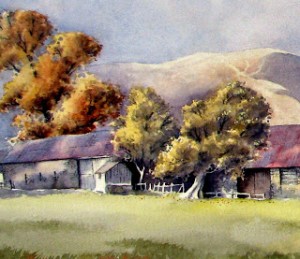I’ve been somewhat distracted over the last week or so, with members of the family sick, hence the lack of posts. We’re experiencing marvellous walking and sketching weather in Wales at the moment, and it’s a lovely time of year for getting out with your sketchbook, flask and sandwiches. Being out amidst nature is one of the most therapeutic ways of casting off the stresses of life.
In a recent comment Mark has enquired about the manner in which 19th-century artists preserved the whites in their watercolours. They did not have any masking fluid available in those days, but they did employ a number of the alternatives that we currently use, although I don’t know many artists these days that rub out areas of watercolour with stale bread, which was a method much used by JMW Turner.

Barn & Trees
The most obvious alternative is that of negative painting, ie,painting the dark spaces around a light object as in the tree-trunks and fence in this watercolour detail. With practice this is an extremely useful technique. You will see that some blue-grey shadows have been painted over the light trunks directly under the foliage where it casts a shadow, yet the trunk still stands out, though less stark. John Cotman, in the early 19th Century exhibited marvellous control of this method, and is a water-colour master well worth studying.
Well before the 19th Century artists used white bodycolour to create highlights, or to render small features such as seagulls, and Turner certainly used it in many of his works. Writers of that period would often refer to this as ‘chalk’, so that the medium used might be referred to as ‘watercolour heightened with chalk’. Turner used numerous techniques to achieve whites, scratching through the darks with a knife, thumbnail or the wrong end of a brush; removing colour with blotting paper; and even stopping out areas with glue size to prevent washes being laid there. The glue size was washed off afterwards, but this technique obviously required great care and expertise, as it would be easy to mess things up at the washing-off stage, but expertise was something which Turner, of course, was not short of!

Voilà les aquarelles que j’adore. Les couleurs et les ombres des arbres me plaisent énormément….et toute l’aquarelle.Champion David.
I’ve never understood why modern ‘purists’ frown on the use of gouache (surely a synonym for ‘body colour’) in watercolours and yet that is what many of the old masters such as Rossetti and, as you say, Turner used to great effect.
I never realised they used glue size like we use masking fluid though!
Another great post David!